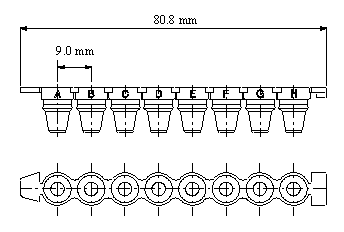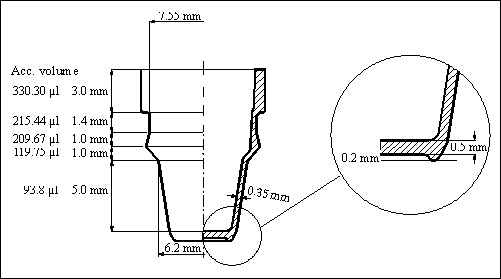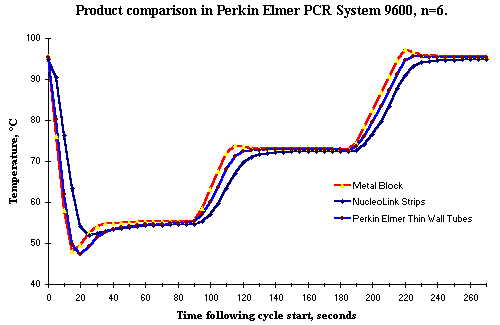Physical facts about the NucleoLink Strips
- Introduction
- Shape and volume of NucleoLink Strips
- Heat transfer to the inside of the NucleoLink Strips
- Heat resistance of NucleoLink Strips
- Autoclaving
- Conclusion
1. Introduction
NucleoLink Strips are designed to resemble the traditional MicroWell® plate format (  ). This design assures that standard MicroWell® equipment, such as plate washers, multi-channel pipettes, and heating blocks, can be used with the NucleoLink Strips (
). This design assures that standard MicroWell® equipment, such as plate washers, multi-channel pipettes, and heating blocks, can be used with the NucleoLink Strips (  ). This design also ensures that the NucleoLink Strips can fit into a frame and be handled like a standard MicroWell® Plate (
). This design also ensures that the NucleoLink Strips can fit into a frame and be handled like a standard MicroWell® Plate (  ).
).
2. Shape and volume of NucleoLink Strips
Figure 1 represents a drawing of a NucleoLink Strip seen from the top and the side. Figure 2 represents a drawing of a single well in the NucleoLink Strips. The shape ensures that it fits into all standard V-shaped 0.2 ml thermal cyclers (  ). The NucleoLink Strips are designed with a flat transparent bottom so the Strips can be measured in a standard ELISA reader (
). The NucleoLink Strips are designed with a flat transparent bottom so the Strips can be measured in a standard ELISA reader (  ). The covered surface areas when filled with the volumes traditionally used in PCR are listed in Table 1. In this table the surface to volume ratios are listed.
). The covered surface areas when filled with the volumes traditionally used in PCR are listed in Table 1. In this table the surface to volume ratios are listed.
| Volume added | Surface area covered | Surface/volume ratio | | 25 µl | 36.9 mm² | 1.48 mm²/µl | | 50 µl | 57.7 mm² | 1.15 mm²/µl | | 100 µl | 102.5 mm² | 1.03 mm²/µl | Table 1: The covered surface area with the volumes normally used in PCR and the ratio between the covered surface area and the volume. |
The volume normally used in the solid phase DNA amplification in DIAPOPS (  ) is 50 µl, but it is possible to use volumes lower than this (
) is 50 µl, but it is possible to use volumes lower than this (  ). Experiments have shown that a volume of 25 µl yields very good results in DIAPOPS (results not shown). The use of this low volume offers a higher surface to volume ratio than with 50 µl, as listed in Table 1. There is more than 20 % more surface covered per microlitre when 25 µl is used. Theoretically, this will increase the possibility of achieving a more efficient solid phase DNA amplification. However, the observed difference in results is very small when 50 µl and 25 µl are used. Consequently, it is often more convenient to use 50 µl because it is simple to handle a larger volume. However, if large scale tests are performed, it is more cost efficient to use the smaller volume.
). Experiments have shown that a volume of 25 µl yields very good results in DIAPOPS (results not shown). The use of this low volume offers a higher surface to volume ratio than with 50 µl, as listed in Table 1. There is more than 20 % more surface covered per microlitre when 25 µl is used. Theoretically, this will increase the possibility of achieving a more efficient solid phase DNA amplification. However, the observed difference in results is very small when 50 µl and 25 µl are used. Consequently, it is often more convenient to use 50 µl because it is simple to handle a larger volume. However, if large scale tests are performed, it is more cost efficient to use the smaller volume.

Figure 1: Drawing of side and top view of NucleoLink Strips. |
Normally, the binding reaction of the phosphorylated solid phase primer to the surface of the NucleoLink Strips is performed in 100 µl (  ) whereas the PCR is only carried out with 25 µl or 50 µl. This difference in volume is included to incorporate a safety margin which ensures that all surface covered by the PCR mix is also bound with solid phase primers. The volumes contained in the NucleoLink Strips when filled to different levels with liquid are listed in Figure 2.
) whereas the PCR is only carried out with 25 µl or 50 µl. This difference in volume is included to incorporate a safety margin which ensures that all surface covered by the PCR mix is also bound with solid phase primers. The volumes contained in the NucleoLink Strips when filled to different levels with liquid are listed in Figure 2.

Figure 2: A drawing of a single well in a NucleoLink Strip. The dimensions are indicated in mm², and the accumulated volumes of liquid in the well, when liquid is filled to the exact line indicated, are listed to the far left in the figure. |
3. Heat transfer to the inside of the NucleoLink Strips
The heat transfer from the thermal block in the thermocycler to the inside of the NucleoLink Strips is excellent, as the walls of the wells in the NucleoLink Strips are only 0.35 mm² thick. These thin walls ensure optimal heat transfer. As seen in Figure 3, there is a very limited difference between the heat transfer to Perkin Elmer Thin Walled Tubes, and to NucleoLink Strips (  ). The flat bottom does not cause any problem with heat transfer in a thermal cycler as thermal cyclers are usually designed with a small space in the bottom. This small space is made to ensure that any difference in height between the PCR vessels will not make the Strips stand on the bottom. If the PCR vessel stands on the bottom, it will be slightly lifted, therefore loose contact with the walls of the heating block in the thermal cycler. This will greatly diminish the efficiency of the heat transfer.
). The flat bottom does not cause any problem with heat transfer in a thermal cycler as thermal cyclers are usually designed with a small space in the bottom. This small space is made to ensure that any difference in height between the PCR vessels will not make the Strips stand on the bottom. If the PCR vessel stands on the bottom, it will be slightly lifted, therefore loose contact with the walls of the heating block in the thermal cycler. This will greatly diminish the efficiency of the heat transfer.
4. Heat resistance of NucleoLink Strips
NucleoLink Strips are heat resistant up to 120ºC. This ensures that the Strips will not melt or be deformed by the heat from the thermal cycler or from the hot lid of the thermal cycler. NucleoLink is an activated resin capable of covalently binding a high amount of DNA in a heat resistant way. This ensures that the bound DNA will not detach during thermal cycling (  ) where temperatures of 94ºC or higher are reached numerous times.
) where temperatures of 94ºC or higher are reached numerous times.

Figure 3: A comparison of heat transfer to liquid in NucleoLink Strips and Perkin-Elmer PCR Thin Wall Tubes. The temperature of the metal block is also indicated. As seen, there is only a very small difference between the temperature inside NucleoLink or TopYield compared to the Perkin Elmer PCR tubes (  ). ). |
5. Autoclaving
The NucleoLink Strips are delivered sterile in a sealed bag. It is therefore not necessary to autoclave the Strips. It is not recommended to autoclave them, because even though they are heat resistant at the autoclaving temperature, there is a possibility that they can be deformed if they are under mechanical pressure.
6. Conclusion
The NucleoLink Strips are made of a resin heat resistant up to 120ºC. The shape with the flat bottom allows the Strips to be read in a standard plate reader. Furthermore, the flat bottom ensures that the strips will not rest on the bottom of the heating block in the thermal cycler. For this reason there will be a uniform heat transfer to all the wells. The heat transfer is excellent due to the very thin walls of the wells in the NucleoLink Strips.
![]() )
)![]() )
)![]() )
)![]() )
)![]() )
)![]() )
)![]() )
)![]() )
)![]() )
)![]() )
)